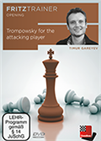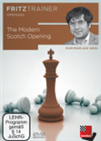A review
I'm preparing for a tournament, I just have 2 weeks, and I have to decide where to dedicate most of my time to get ready. Yes, openings are fundamental, because if we don't pass the opening stage, all the rest doesn't matter, but thanks to other Chessbase DVDs I think I got that covered.
What I'm really looking for at the moment is creativity, imagination, that little spark which will help me beat the competition. I think I found it in this DVD, where GM Simon Williams shows us some of the most beautiful moves played.
Some coaches also advocate reviewing favourite games before a tournament. Games where sacrifices or some special patterns are shown. I do have, in fact, a database of favourite games which I watch from time to time before a tournament.
A DVD like the one made by Williams is important because it can increase our enjoyment of the game. Often at an amateur level, it is difficult to understand why some moves are played, but when we are brought around by a GM who points at important critical moments of the game, then we learn to appreciate chess like a sommelier does a good wine.
The funny thing is, Williams presents the first game played by a friend of his, who has given up the classical Dutch, one of Williams' all-time favourites, for playing the triangle Slav. This friend was telling him how well prepared he was: he lost the game in 12 moves. Now, in my opinion, the truth about the openings is that we do need to lose tournament games in order to really understand where our preparation faltered. Most openings nowadays are complex and deep, but like GM Mihail Marin says in another DVD, one should play a game, study, play another game, study a little more. In this way, one can become an expert in that opening.
I agree with Williams the following is a beautiful position...

But why is beautiful? Let's examine it. Black has a Ke8, a Bf8, a Ng8, and a Rh8... Oh wait — that Bf8 is a white bishop, not the black one! How did it go there?
Here the complete game for those who are curious:
The polish GM Michal Krasenkow presents a repertoire based on the Noteboom and the Stonewall. Black's set-up may lead to a whole range of different and interesting positions, which help the black player to broaden his strategic and tactical understanding.
The Semi-Slav defense (1.d4 d5 followed by ...e7-e6 and ...c7-c6) is one of the most popular opening set-ups for Black. Black can follow two entirely different concepts.
Williams, throughout the presentation of the games, also shows how he learned from these games and how he tried to apply the ideas learned in his own games. Obviously, I hope to do the same.
When I watch a DVD, I try to be as active as possible. I don't just watch for the sake of watching, but I try to learn everything from the GM I'm watching. In this case, in the second game, Williams showed an amazing idea by Alekhine, and he mentioned that Richard Rapport has similar crazy ideas in his games. Once I heard this, I became curious. I stopped the video and went to see if I could locate some of Rapport's games with interesting ideas. Here the result:
 Tap into your creative mind and start the game on a fresh note. The Trompowsky (1.d4 Nf6 2.Bg5) is an opening outside of conventional wisdom. Create challenges and make your opponent solve problems early on.
Tap into your creative mind and start the game on a fresh note. The Trompowsky (1.d4 Nf6 2.Bg5) is an opening outside of conventional wisdom. Create challenges and make your opponent solve problems early on.As you can see these four games show amazing moves, and of course, many more can be found on this great player, but the point was to use our "watching" time actively, to learn as much as we can, like if Williams was our coach, and was teaching us!
If this DVD was only about beautiful games, we wouldn't learn much. Because while it is certainly pleasant to witness the richness of human creativity, at the same time I still have a tournament in a couple of weeks, and I wouldn't like to be portrayed in a possible sequel: Amazing Moves 2, as one of those who falls to the creativity of someone else. Here the Fritz Trainer interactive system comes in handy. Throughout the DVD Williams stops in some positions, and sometimes ask to find the key move as combination or tactic, but he also asks us to put ourselves in the place of the defender, and find the best move to avoid the loss. These exercises are useful to improve our chess because we are exposed to a variety of positions which come from different epochs, and different personalities, while at the same time using our chess brains to learn.
By the way when we are asked to find a move, often we don't find the correct one (notice the "We" — I couldn't admit it was "me" not finding it!), or we find one which could be partially good. In that case, there is a video clip made by Williams which explain why the move chosen wasn't the best one.
The DVD comes with the 38 games on which the videos are based, plus an extra database with 50 games. Most of the games in this second database come with "training questions" which means that if we have activated the "training" in Chessbase 14 (but the same for previous version, I remember I had it on Chessbase 12) when reached the position with the diagram, the game will stop, and ask a question, upon finding the right move, the game goes on.
Some wisdom to be gained from the DVD
- Calculation is key in everything we do in chess
- Intuition: since we are not playing against engines, and we cannot calculate everything, it is important to learn to feel when the position is ready to be opened, and an attack to be made. (Intuition is when one cannot calculate every line till the end, but the feeling is overwhelming, watch the Negi vs Vaibhav game later as an example)
- Games are played with time controls — when one sacrifices the other player begins to think more, and while the defending player can find many correct defensive moves, in the end, he can make a big blunder due to the huge amount of time used to find those moves.
Of course, there is much more wisdom shared by Williams, but I wanted to show how useful some of the ideas are, for orienting us in this ocean we call chess!
The material taught by GM Williams has made me want to see more amazing moves, and this is one of the amazing games I found, but first, before watching the game, try to guess what White played on the 13th move:
 In this DVD, Parimarjan Negi looks at the latest revolution in Scotch theory that has completely changed white’s plans, and once again brought back the interest of the world’s elite.
In this DVD, Parimarjan Negi looks at the latest revolution in Scotch theory that has completely changed white’s plans, and once again brought back the interest of the world’s elite.
Here is the game for those interested to check if they found the amazing move played by GM Negi, a brilliant Indian player.
I found also another game which I think could be great for an Amazing Moves 2. The game is great also for another reason: There are many lines to calculate, and it could be used by a coach asking a student to find the right continuation at many of the critical moments.
Final thoughts
I like the fast-paced, humoured tone, used by Williams to comment the games and give feedback. I hope he will make another DVD of Amazing Moves, because I thoroughly enjoyed this one, and wish to have more. Notice this DVD is between 5 or 6 hours long. The cost of a GM is generally around $100 per hour, so clearly, the value we get is around $5-600!!
The interactive format encourages the viewer to study and find the brilliancy, following the footsteps of some of the greatest players of the game.
Links
























